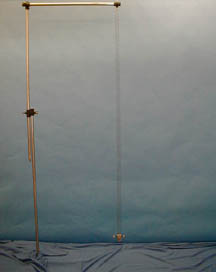Demos: 1S-07 Wilberforce Pendulum

If a weight oscillates up and down at the end of a helical spring, the weight not only moves vertically, but because of the twisting of the spring as it oscillates, the weight undergoes a rotational oscillation as well. Thus we have the combination of two modes of oscillation, vertical and torsional. The rotational inertia of the weight can be adjusted so that the periods of vertical and torsional oscillations are the same. Then if the oscillations are started in one mode, the impulses are transmitted to the other mode, which increases in amplitude and goes through a maximum, as in the case of coupled pendulums.
Directions: Test the apparatus ahead of time, and, if needed, adjust the rotational inertia of the weight by changing the positions of the nuts on the screw thread until the two oscillations have approximately the same frequency. Then pull the weight straight down and release. The weight will undergo vertical oscillations, but it is seen that the weight starts to oscillate in a horizontal plane as a torsional pendulum. The amplitude of the vertical oscillation diminishes as the amplitude of the torsional oscillation increases. If adjusted properly, each of the oscillations will have near zero amplitude while the other has maximum amplitude.
Suggestions for Presentation: Probably any earlier demos showing SHM with a mass and spring concentrated on the vertical oscillations. The heavy ball at the end of the spring did undergo some torsional oscillations, but were small compared with the vertical ones. Without much discussion, simply ask the class what will happen if you pull the weight down and let go. Likely answers will center around the idea that it will undergo vertical oscillations as SHM. Then pull down the weight and let it go. Students are usually quite surprised at the ensuing motion. See if they can figure out how the weight got its torsional motion. They probably have never though about the fact that the spring “unwinds” as it moves downward.
Applications: None that are obvious.
Last Updated: Nov 30, 2023 11:25 AM